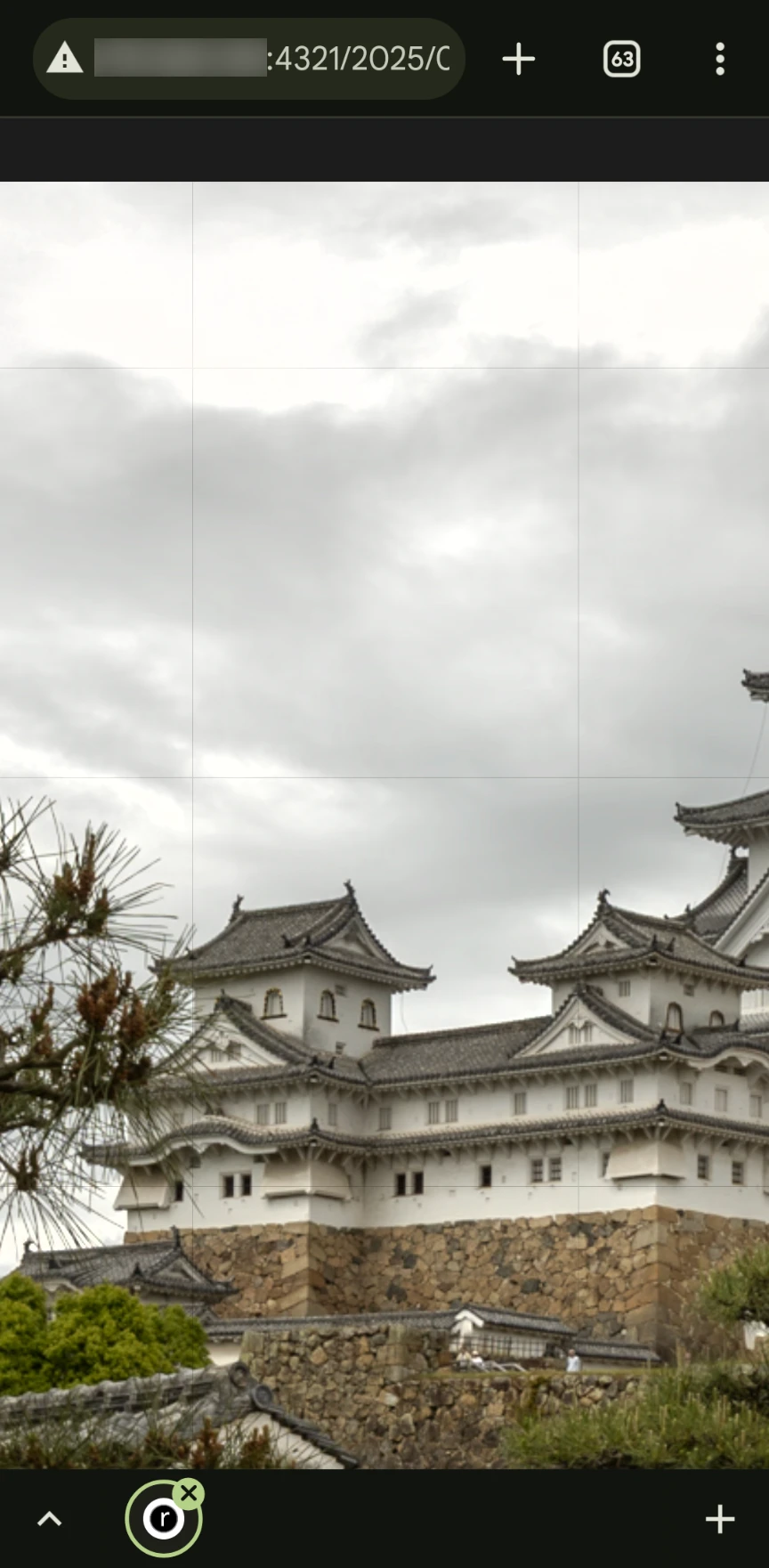Playing around with HDR AVIF images
• 9 min read
At some point, I noticed various bits of HDR functionality popping up in Adobe Lightroom. I had largely ignored them (somewhat thinking HDR is a bit of a gimmick). Recently, though, I decided to have a play around with them.
I gave Lightroom’s HDR editing mode a try on a picture of Himeji Castle, in Japan, that I took on a Canon EOS R full-frame camera. This is the SDR version of that image – as I had previously edited it – exported using Adobe Lightroom to an sRGB AVIF file:

And here is an HDR version of the photo, saved to three slightly different AVIF files that you can toggle between in this widget (along with the SDR image from above):
When viewed with a compatible browser on an HDR display, the HDR images should look just like the SDR version, but with more brightness and brightness variation in the brightest parts of the sky.
But it’s also interesting to see how those images look in less favourable scenarios – on an SDR display, or when viewed with incompatible software, for example.
Compatible browsers are currently mainly some Chromium-based ones, such as Chrome and Edge. For me, my Pixel 8 smartphone makes a good test device for viewing the images correctly.
(Also, what I haven’t done here is intentionally fiddled with the colours of the image to make them more saturated – HDR or not, I like my photos to look vaguely realistic.)
What’s the difference between the three HDR images?
The ‘HDR (nclx colour type)’ image was saved directly from Lightroom, with
‘Maximize Compatibility’ turned off. An nclx colour type means that, rather
than having a colour profile embedded in the image file, the image’s colour
information is specified using a few simple values in what is called the colr
(colour information) box. (Those values are called
coding-independent code points (CICP),
and libavif has
an article on them in the context of AVIF.)
The ‘HDR (gain map)’ image was saved directly from Lightroom, with ‘Maximize Compatibility’ turned on. The file actually contains two images – an SDR base image and an HDR gain map. (This means the file is larger than a pure SDR or HDR image.)
The advantage of using a gain map is that you have more control over what the image looks like when displayed in SDR (or by something that doesn’t understand the gain map). In practice, though, I had to fiddle around quite a bit in Lightroom to get the SDR base image looking close to what I had before HDR editing mode was turned on (and even then, there are still some noticeable differences).
The ‘HDR (ICC profile)’ image, uses a colour type of rICC and contains an ICC
profile. I created the image by exporting the photo to a lossless JPEG XL file
(using Lightroom) and then converting that to an AVIF file using the libvips
heifsave CLI command.
If you want to find some details about how colour information is specified in an
AVIF file, ExifTool and avifdec (from
libavif) can do the job. With
ExifTool, you can run (for example):
exiftool -g -Quicktime:all -ICC_Profile:all <file>Example output for the nclx image
---- QuickTime ----
Major Brand : AV1 Image File Format (.AVIF)
Minor Version : 0.0.0
Compatible Brands : avif, mif1, miaf, MA1A
Handler Type : Picture
Handler Description : AVIF Still Picture
Primary Item Reference : 1
Image Spatial Extent : 1400x933
Image Pixel Depth : 10 10 10
AV1 Configuration Version : 1
Chroma Format : YUV 4:4:4
Chroma Sample Position : Unknown
Color Profiles : nclx
Color Primaries : BT.709
Transfer Characteristics : SMPTE ST 2084, ITU BT.2100 PQ
Matrix Coefficients : BT.601
Video Full Range Flag : Full
Max Content Light Level : 480
Max Pic Average Light Level : 21
Media Data Size : 456467
Media Data Offset : 444Example output for the ICC profile image
---- QuickTime ----
Major Brand : AV1 Image File Format (.AVIF)
Minor Version : 0.0.0
Compatible Brands : avif, mif1, miaf
Handler Type : Picture
Primary Item Reference : 1
AV1 Configuration Version : 1
Chroma Format : YUV 4:4:4
Chroma Sample Position : Colocated
Image Spatial Extent : 1400x933
Image Pixel Depth : 12 12 12
Media Data Size : 608677
Media Data Offset : 4746
---- ICC_Profile ----
Profile CMM Type : Unknown (jxl )
Profile Version : 4.4.0
Profile Class : Display Device Profile
Color Space Data : RGB
Profile Connection Space : Lab
Profile Date Time : 2019:12:01 00:00:00
Profile File Signature : acsp
Primary Platform : Apple Computer Inc.
CMM Flags : Not Embedded, Independent
Device Manufacturer :
Device Model :
Device Attributes : Reflective, Glossy, Positive, Color
Rendering Intent : Perceptual
Connection Space Illuminant : 0.9642 1 0.82491
Profile Creator : Unknown (jxl )
Profile ID : f463500b39004f89623f245f4c47d1f6
Profile Description : RGB_D65_SRG_Per_PeQ
Profile Copyright : CC0
Media White Point : 0.9642 1 0.82491
Chromatic Adaptation : 1.04785 0.0229 -0.05016 0.02957 0.99048 -0.01706 -0.00925 0.01506 0.75197
Color Primaries : BT.709
Transfer Characteristics : SMPTE ST 2084, ITU BT.2100 PQ
Matrix Coefficients : Identity matrix
Video Full Range Flag : Full
Red Matrix Column : 0.43602 0.22249 0.01392
Green Matrix Column : 0.3851 0.7169 0.09709
Blue Matrix Column : 0.1431 0.06062 0.7142
A To B0 : (Binary data 3772 bytes, use -b option to extract)
B To A0 : (Binary data 80 bytes, use -b option to extract)With avifdec, you can run:
avifdec --info <file>That will give you the raw numeric values for some of the properties (which can be looked up in the libavif source code, the non-free ISO/IEC 23091-2 standard, or the public H.273 standard), and will also provide gain map information.
Example avifdec --info output for the gain map image
Decoding with codec 'dav1d' (32 worker threads), please wait...
Image decoded: 189A4328.hdr-gain-map.avif
* Resolution : 1400x933
* Bit Depth : 10
* Format : YUV444
* Alpha : Absent
* Range : Full
* Color Primaries: 1
* Transfer Char. : 13
* Matrix Coeffs. : 6
* ICC Profile : Absent
* XMP Metadata : Present (14267 bytes)
* Exif Metadata : Present (810 bytes)
* Transformations: None
* Progressive : Unavailable
* Gain map : 1400x933 pixels, 10 bit, YUV444, Full Range, Matrix Coeffs. 6, Base Image is SDR
* Alternate image:
* Color Primaries: 9
* Transfer Char. : 16
* Matrix Coeffs. : 9
* ICC Profile : Absent
* Bit Depth : 10
* Planes : 3
* 1 timescales per second, 1.00 seconds (1 timescales), 1 frame
* Frame:
* Decoded frame [0] [pts 0.00 (0 timescales)] [duration 1.00 (1 timescales)] [1400x933]How do the HDR images look in different browsers and software?
On my Pixel 8 and Windows 11 laptop (with a built-in DisplayHDR 400 screen, and
HDR turned on in Windows), the nclx and ICC profile images appear to look
identical in Chrome (compression artefact differences aside). The gain map
version has a few oddities, though. On Chrome stable on my laptop and in Chrome
Dev and Canary on my Pixel 8, the gain map image has a very slight colour shift
in the sky (not easily noticed, admittedly).
In Chrome stable and Chrome Beta on my Pixel 8, the gain map image is marginally darker than the other two HDR images for some reason. But there’s an even weirder problem with the gain map image in Chrome – when you zoom in, odd grid lines appear1:

And on Windows 11 on my desktop (with a DisplayHDR 400 monitor, and HDR turned on in Windows), all versions of Chrome seem to display all three HDR images slightly differently for some reason. (Whether the three HDR images should technically look the same when viewed in HDR, I don’t know. From a user perspective, though, I would’ve expected them to.) Also, be aware of how HDR brightness is handled in Chrome on Windows.
What about Firefox? It doesn’t support HDR images at all and
displays the nclx colour type image very darkly.
With the gain map version, you at least get the (mostly) good SDR base image.
(The ICC profile image isn’t terrible either, but it’s a bit darker than gain
map and SDR images and has an odd slight colour cast.)
Of the three HDR images, the Windows 11 Photos app renders only the nclx one
in HDR. (HDR in Windows is also a bit of a pain, as you have to manually turn it
on, which makes everything including your desktop look different.)
In a web context, image processing tools are also relevant. I typically use
libvips (often via
sharp) to generate
responsive images
on my websites. libvips currently
does not support the nclx colour type
or gain maps. And so, if I
want to create responsive images from a source HDR AVIF file using libvips, I
have to avoid the nclx colour type and ensure the image has a colour profile
embedded (for now, at least). (Unfortunately, I haven’t been able to get sharp
to handle an HDR image correctly at all, but that’s not the end of the world as
I can use libvips directly.)
Wrapping up
The reality is support for HDR images is (currently) variable and inconsistent. So, having an SDR version of an image (whether separate or via a gain map) is important if you want your images to look good.
In Lightroom, for most images, enabling HDR editing mode preserved the existing look of the image while extending the brightness range. For some images, though, enabling HDR editing mode completely changed the look of the image and I struggled to get it back to how it was before. (This mainly seemed to happen with images where I’d previously fiddled with the tone curve.) And, even in the cases where Lightroom preserved the general look of the image after enabling HDR editing mode, the SDR rendition of the HDR image (seen when enabling ‘Preview for SDR Display’) had still changed quite a bit (affecting how the image looks in SDR if going down the gain map approach). Perhaps, if you start out editing an image in HDR mode, you’d be less bothered by these points.
I also feel that ‘Maximize Compatibility’ is a bit of a misnomer in Lightroom. The reality is that not everything supports gain maps (and there still seem to be some kinks being worked out).
There are also web-specific concerns when it comes to HDR images, like:
- having the tooling to generate responsive HDR images
- being able to change behaviour depending on browser support (whether to pick the correct image to use, or to give users an option for whether they want to see HDR images)
- dealing with inconsistent behaviour between browsers, operating systems and HDR displays
- file size-related concerns (whether it’s the built website being bigger, or users being served more data)
One concern I had with gain maps is how a user could still be allowed to select
between an SDR and an HDR version of the image. The new
dynamic-range-limit CSS property
appears to solve that, at least.
Perhaps surprisingly, given those points, I recently added some HDR images to
my photos site. For now, it’s using separate SDR
and HDR images, with a control to toggle between the two appearing when using a
Chromium-based browser with an HDR display (detected using a combination of
navigator.userAgentData.brands2
and the
dynamic-range media query).
(For what it’s worth, I do like having the extra brightness range of HDR images available, and it seems silly for my camera photos to be disadvantaged compared to smartphone photos that have been saved in an HDR image format.)


